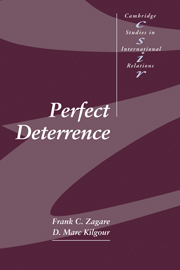Book contents
- Frontmatter
- Contents
- List of figures
- List of tables
- Preface
- Part I Theoretical underpinnings
- 1 Classical deterrence theory
- 2 Rationality and deterrence
- 3 Credibility and deterrence
- Part II Direct deterrence
- Part III Extended deterrence
- Part IV Implications
- Appendices
- 1 Deterrence models
- References
- Index
- CAMBRIDGE STUDIES IN INTERNATIONAL RELATIONS
1 - Classical deterrence theory
Published online by Cambridge University Press: 01 October 2009
- Frontmatter
- Contents
- List of figures
- List of tables
- Preface
- Part I Theoretical underpinnings
- 1 Classical deterrence theory
- 2 Rationality and deterrence
- 3 Credibility and deterrence
- Part II Direct deterrence
- Part III Extended deterrence
- Part IV Implications
- Appendices
- 1 Deterrence models
- References
- Index
- CAMBRIDGE STUDIES IN INTERNATIONAL RELATIONS
Summary
International relations is a study that is plagued with platitudes.
A.F.K. OrganskiFor over forty-five years, the rivalry between the United States and the Soviet Union defined the world we live in. Civil wars in Africa, coups d'état in Latin America, revolutions in Asia, and small wars around the globe were filtered through the prism of the Cold War, not only in Washington and Moscow, but in just about every major capital on the planet.
The global contest between the superpowers was both dramatic and dangerous. As is generally the case in hegemonic competitions, the stakes were high: control of the international system lay in the “balance.” But for some, and later most, strategic thinkers, the dropping of atomic bombs on Hiroshima and Nagasaki instantly and permanently changed the nature of the international system and the laws that govern it. Bernard Brodie was the first to argue that the world before 1945 was fundamentally different from the world that would follow. Up to that point, he argued, “the chief purpose of our military establishment [had] been to win wars. From now on its chief purpose must be to avert them. It can have almost no other purpose” (Brodie, 1946: 76).
If the post-World War II world were truly sui generis, as Brodie and others argued, then a new theory would be needed to replace the conventional wisdom of the past. The enormous costs associated with warfare after 1945 would clearly be the cornerstone of this new theory.
- Type
- Chapter
- Information
- Perfect Deterrence , pp. 3 - 36Publisher: Cambridge University PressPrint publication year: 2000



